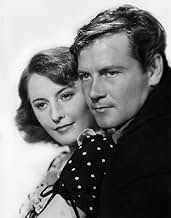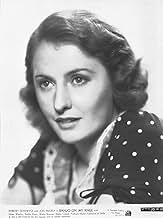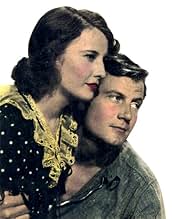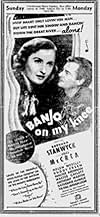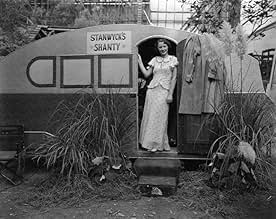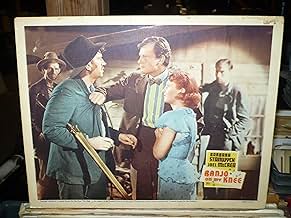AVALIAÇÃO DA IMDb
6,1/10
721
SUA AVALIAÇÃO
Adicionar um enredo no seu idiomaBelieving he has killed a guest, a groom flees on his wedding night.Believing he has killed a guest, a groom flees on his wedding night.Believing he has killed a guest, a groom flees on his wedding night.
- Direção
- Roteiristas
- Artistas
- Indicado a 1 Oscar
- 1 vitória e 1 indicação no total
Tony Martin
- Chick Bean
- (as Anthony Martin)
Katherine DeMille
- Leota Long
- (as Katherine De Mille)
Hall Johnson Choir
- Vocal Ensemble
- (as The Hall-Johnson Choir)
Herbert Ashley
- Minor Role
- (não creditado)
Fred Behrle
- Minor Role
- (não creditado)
- Direção
- Roteiristas
- Elenco e equipe completos
- Produção, bilheteria e muito mais no IMDbPro
Avaliações em destaque
Rather ill-conceived and condescending Fox musical study of "river folk," meaning mindless Southerners who overreact to perceived slights and say "dad-blamed" a lot. River lad Joel McCrea, always appealing but playing a really unlikable leading man, marries "land girl" Barbara Stanwyck, none too bright herself, then high-tails it to Europe on his wedding night when he mistakenly thinks he's killed Victor Kilian, who got fresh with his bride. Walter Brennan's his superannuated dad; if you like Brennan's style of corn pone and shtick you'll like him here, but I don't. Stanwyck, surprisingly believing the lies of citified Walter Catlett, follows him to New Orleans, then has second thoughts, and ends up washing dishes in Minna Gombell's cafe, where she also harmonizes with Tony Martin and soft-shoes a bit with Buddy Ebsen. I love Stanwyck, but singing and dancing really aren't her fortes, and one is constantly aware that she's more intelligent than the woman she's playing. More interesting is a scowling, Joan-Crawford-looking Katherine de Mille, as her nasty rival. There are some nice musical interludes, notably an elaborate "St. Louis Blues" with the Hall Johnson Choir, but the plot meanderings are arbitrary and the ending's never in doubt. Nicely photographed, with an impressive river storm near the end.
BANJO ON MY KNEE (20th Century-Fox, 1936), directed by John Cromwell, teams Barbara Stanwyck and Joel McCrea for the second of six times on screen. It may not be the first motion picture in which Stanwyck sings and dances (barely), but her initial one to be classified as a musical. Following the pattern taken on the idea from Edna Ferber's story, "Show Boat," later a legendary Broadway musical followed by two screen based versions (1929, 1936), BANJO ON MY KNEE, based on the novel by Harry Hamilton, has a pattern all its own.
Opening title: "Island Number 21 is little more than a sandbar in the Mississippi River, but to the shanty boat people moored there it is the world. Of what happens on shore they know little or care less. Shanty boat people firmly believe that if God had intended folks to live in towns, He would have created towns at the same time He created rocks and trees and rivers." The story opens with on a shanty boat on the Mississippi River where Judge Pope (Spencer Charters) officiates the wedding for bride and groom, Polly (Barbara Stanwyck), a "land girl," to Ernie (Joel McCrea), a "river man" and son of Newt (Walter Brennan), whose biggest wish before he dies is to become a grandfather. Among those not present at the wedding is the jealous Leota Lang (Katherine DeMille), Ernie's former girlfriend. Following a ceremony where Buddy (Buddy Ebsen) does some dancing, Mr. Slade (Victor Kilian), one of Newt's biggest buyer of animal feed, arrives, wanting to kiss the bride. The forceful kiss forces Ernie to sock Slade into the river. Fearing that he has drowned, Leota, seeing her chance to ruin Ernie's wedding night, notifies the police so he can be arrested for murder. The police arrive, forcing Ernie to leave his bride and swim away to shore. Not soon after Ernie's escape, the soaked and dripping Mr. Slade reappears, having survived drowning by floating upstream. Six months later, after traveling around Europe, Ernie returns to Pearl only to get into a heated argument causing Pearl to walk out on her "bullheaded" husband. After Pearl goes away with photographer, Warfield Scott (Walter Catlett), on a promise of a job in Louisiana, both Newt and Ernie go after her. During their search, Pearl encounters a new career and partnership with Chick Bean (Anthony "Tony" Martin), singer at the Creole Cafe.
While the words and music by Jimmy McHugh and Harold Adamson are far from Oscar Hammerstein's immortal songs from "Show Boat," the songs are satisfactory for easy listening. The motion picture soundtrack includes: "With a Banjo on My Knee" (sung by Buddy Ebsen and Walter Brennan); "Where the Lazy River Goes By" (sung by Barbara Stanwyck to Joel McCrea); "There's Something in the Air" (sung by Tony Martin); W.C. Handy's "The St. Louis Blues" (sung by Theresa Harris/the Hall Johnson Choir); "Four Leaf Clover" "Oh, Susannah" (by Stephen Foster/ played on "contraption" by Walter Brennan); "Swanee River" (by Stephen Foster); "Where the Lazy River Goes By" (reprised by Stanwyck and Martin); "With a Banjo on My Knee" (sung/danced by Ebsen)"Swanee River" (danced by Ebsen and Stanwyck); and "With a Banjo On My Knee."
Though not in the same level as Universal's second presentation of SHOW BOAT (1936) starring Irene Dunne and Allan Jones, nor the curiosity of the seldom seen MISSISSIPPI (Paramount, 1935) featuring the likes of Bing Crosby and WC Fields, BANJO ON MY KNEE is routinely done. Song interludes provide good showcases for its performers, and a great surprise for many getting a glimpse of Stanwyck singing a song or two in ballad style, and dancing with Buddy Ebsen. Of the many tunes, Tony Martin's rendition of "There's Something in the Air" comes off best. The "St. Louis Blues" number, done in black spiritual style, begins in a similar fashion of "Ol' Man River" from SHOW BOAT. There's no Paul Robeson to stop the show here this time around, but Theresa Harris sharing her vocals with the Hall Johnson Choir, and quite effectively, too. Another highlight is Walter Brennan playing an assortment of old time tunes on his "contraption," and Walter Catlett constant avoiding a sock on the jaw.
In support is Helen Westley, through her limitations, stands out as the old granny in a rocking chair smoking a corn cob pipe and screeching a hideous laugh in the manner of an old hag. Then there's Minna Gombell, whose characterization is a close reminder of Gladys George. In the role of Ruby, a tough talking café girl, she becomes romantically involved with Ernie (McCrea) at one point, unknown that he's a married man.
Even during the broadcast TV generation of the 1960s and 70s, BANJO ON MY KNEE had its limitations, especially when last seen on the afternoon movie presentation in the New York City area where it was last seen as far back as 1970 on WOR, Channel 9. I didn't get to see this one again until the early stages of American Movie Classics cable channel prior to 1988, where it hasn't been revived since. BANJO ON MY KNEE did have some broadcasts in later years on the Fox Movie Channel. Even with occasional revivals, particularly Turner Classic Movies (TCM premiere: December 12, 2012), it's still not enough to become a well-known factor of thirties cinema.
BANJO ON MY KNEE may not win any merits as the finest musical with the most original story ever put on film, but does benefit greatly from some fine atmospheric settings depicting both Mississippi and Louisiana, folksy humor and fine chemistry between Stanwyck and McCrea to make this rarity something to consider. (*** banjos)
Opening title: "Island Number 21 is little more than a sandbar in the Mississippi River, but to the shanty boat people moored there it is the world. Of what happens on shore they know little or care less. Shanty boat people firmly believe that if God had intended folks to live in towns, He would have created towns at the same time He created rocks and trees and rivers." The story opens with on a shanty boat on the Mississippi River where Judge Pope (Spencer Charters) officiates the wedding for bride and groom, Polly (Barbara Stanwyck), a "land girl," to Ernie (Joel McCrea), a "river man" and son of Newt (Walter Brennan), whose biggest wish before he dies is to become a grandfather. Among those not present at the wedding is the jealous Leota Lang (Katherine DeMille), Ernie's former girlfriend. Following a ceremony where Buddy (Buddy Ebsen) does some dancing, Mr. Slade (Victor Kilian), one of Newt's biggest buyer of animal feed, arrives, wanting to kiss the bride. The forceful kiss forces Ernie to sock Slade into the river. Fearing that he has drowned, Leota, seeing her chance to ruin Ernie's wedding night, notifies the police so he can be arrested for murder. The police arrive, forcing Ernie to leave his bride and swim away to shore. Not soon after Ernie's escape, the soaked and dripping Mr. Slade reappears, having survived drowning by floating upstream. Six months later, after traveling around Europe, Ernie returns to Pearl only to get into a heated argument causing Pearl to walk out on her "bullheaded" husband. After Pearl goes away with photographer, Warfield Scott (Walter Catlett), on a promise of a job in Louisiana, both Newt and Ernie go after her. During their search, Pearl encounters a new career and partnership with Chick Bean (Anthony "Tony" Martin), singer at the Creole Cafe.
While the words and music by Jimmy McHugh and Harold Adamson are far from Oscar Hammerstein's immortal songs from "Show Boat," the songs are satisfactory for easy listening. The motion picture soundtrack includes: "With a Banjo on My Knee" (sung by Buddy Ebsen and Walter Brennan); "Where the Lazy River Goes By" (sung by Barbara Stanwyck to Joel McCrea); "There's Something in the Air" (sung by Tony Martin); W.C. Handy's "The St. Louis Blues" (sung by Theresa Harris/the Hall Johnson Choir); "Four Leaf Clover" "Oh, Susannah" (by Stephen Foster/ played on "contraption" by Walter Brennan); "Swanee River" (by Stephen Foster); "Where the Lazy River Goes By" (reprised by Stanwyck and Martin); "With a Banjo on My Knee" (sung/danced by Ebsen)"Swanee River" (danced by Ebsen and Stanwyck); and "With a Banjo On My Knee."
Though not in the same level as Universal's second presentation of SHOW BOAT (1936) starring Irene Dunne and Allan Jones, nor the curiosity of the seldom seen MISSISSIPPI (Paramount, 1935) featuring the likes of Bing Crosby and WC Fields, BANJO ON MY KNEE is routinely done. Song interludes provide good showcases for its performers, and a great surprise for many getting a glimpse of Stanwyck singing a song or two in ballad style, and dancing with Buddy Ebsen. Of the many tunes, Tony Martin's rendition of "There's Something in the Air" comes off best. The "St. Louis Blues" number, done in black spiritual style, begins in a similar fashion of "Ol' Man River" from SHOW BOAT. There's no Paul Robeson to stop the show here this time around, but Theresa Harris sharing her vocals with the Hall Johnson Choir, and quite effectively, too. Another highlight is Walter Brennan playing an assortment of old time tunes on his "contraption," and Walter Catlett constant avoiding a sock on the jaw.
In support is Helen Westley, through her limitations, stands out as the old granny in a rocking chair smoking a corn cob pipe and screeching a hideous laugh in the manner of an old hag. Then there's Minna Gombell, whose characterization is a close reminder of Gladys George. In the role of Ruby, a tough talking café girl, she becomes romantically involved with Ernie (McCrea) at one point, unknown that he's a married man.
Even during the broadcast TV generation of the 1960s and 70s, BANJO ON MY KNEE had its limitations, especially when last seen on the afternoon movie presentation in the New York City area where it was last seen as far back as 1970 on WOR, Channel 9. I didn't get to see this one again until the early stages of American Movie Classics cable channel prior to 1988, where it hasn't been revived since. BANJO ON MY KNEE did have some broadcasts in later years on the Fox Movie Channel. Even with occasional revivals, particularly Turner Classic Movies (TCM premiere: December 12, 2012), it's still not enough to become a well-known factor of thirties cinema.
BANJO ON MY KNEE may not win any merits as the finest musical with the most original story ever put on film, but does benefit greatly from some fine atmospheric settings depicting both Mississippi and Louisiana, folksy humor and fine chemistry between Stanwyck and McCrea to make this rarity something to consider. (*** banjos)
"Banjo on my Knee" is a 1936 film that will keep you guessing as to which direction it's headed nearly every time there's a scene change. McCrea plays a shantytown boy who marries a land girl (Stanwyck). The patriarch of McCrea's family, played by Walter Brennan, is desperate for a grandchild. Unfortunately, Stanwyck and McCrea can't seem to get their marriage consummated. On their wedding night, they think McCrea has murdered someone (he hasn't), so McCrea takes off for six months and sees the world while his wife waits none too patiently. The day he comes home, he talks about moving the family to Aruba and says he'll go down first for a month and then send for her. The couple get into a terrible fight because Stanwyck doesn't want to be left again. The two of them then split up again - that instant. She goes to New Orleans to work for a slimy photographer, but no sooner does she get to his apartment that she bolts and takes a job as a dishwasher in a bar.
Soon, the entire population of Shantytown is in New Orleans looking for her and for McCrea. At the bar, Tony Martin is a saloon singer who falls for Stanwyck, and soon, Buddy Ebsen, another Shantytown resident, and Walter Brennan are big hits performing there, and Stanwyck is doing duets with Martin. It goes on from there.
Some of the music is great, the highlight being "St. Louis Woman" with Brennan and the Hall Johnson Choir. Martin looks and sounds like an angel - his voice is just stunning in "There's Something in the Air" and "Where the Lazy River Goes By." Stanwyck sings just like she talks - her voice is low, pleasant, and natural. The cast is uniformly good, and Katharine DeMille has a showy role as Leota, who's in love with McCrea. McCrea, of course, is tall, handsome, and boyishly gorgeous.
I wasn't expecting a musical, and in the beginning, "Banjo on My Knee" seemed like a drama, so I never was sure what I was watching. Odd though the film may be, it was loads of fun.
Soon, the entire population of Shantytown is in New Orleans looking for her and for McCrea. At the bar, Tony Martin is a saloon singer who falls for Stanwyck, and soon, Buddy Ebsen, another Shantytown resident, and Walter Brennan are big hits performing there, and Stanwyck is doing duets with Martin. It goes on from there.
Some of the music is great, the highlight being "St. Louis Woman" with Brennan and the Hall Johnson Choir. Martin looks and sounds like an angel - his voice is just stunning in "There's Something in the Air" and "Where the Lazy River Goes By." Stanwyck sings just like she talks - her voice is low, pleasant, and natural. The cast is uniformly good, and Katharine DeMille has a showy role as Leota, who's in love with McCrea. McCrea, of course, is tall, handsome, and boyishly gorgeous.
I wasn't expecting a musical, and in the beginning, "Banjo on My Knee" seemed like a drama, so I never was sure what I was watching. Odd though the film may be, it was loads of fun.
... one of the most bizarre movie musicals ever made. As someone else mentioned, this film makes more sense if you think about when it was made - 1936 - and what it represents - the marriage of Darryl F. Zanuck's 20th Century Pictures that was aiming to make a name for itself in musicals and with well-known stars, and failing Fox Films, which had specialized in films for and about rural folk from its inception until its bankruptcy in 1935. This film was made the year after their merger and so the aims of both companies show through. What results is a rustic semi-musical about rural Southern folk starring two stars (Stanwyck and McCrea) who do their best but really don't belong here. Buddy Ebsen and Walter Brennan seem much more at home here with charming performances you'll expect given their roles in other films.
What's a shame is that Barbara Stanwyck really isn't given more to do here. What's also a shame is that Joel McCrea, an actor who is a favorite of mine, is relegated to the part of the mindless muscle. He thinks with his fists, takes actions that make no sense when those fists have consequences, is kind and even obliging to people that are obviously trying to use him, and thoughtless to those who love him.
I really liked the musical performances and I thought the tunes were quite catchy and memorable. It's just a shame more effort wasn't put into making a story that played to Stanwyck and McCrea's strengths.
What's a shame is that Barbara Stanwyck really isn't given more to do here. What's also a shame is that Joel McCrea, an actor who is a favorite of mine, is relegated to the part of the mindless muscle. He thinks with his fists, takes actions that make no sense when those fists have consequences, is kind and even obliging to people that are obviously trying to use him, and thoughtless to those who love him.
I really liked the musical performances and I thought the tunes were quite catchy and memorable. It's just a shame more effort wasn't put into making a story that played to Stanwyck and McCrea's strengths.
I have not only seen the movie but also had the privilege of reading the book. The book was well written and as in most cases was better then the movie. I am a bit partial seen as how I also knew the writer. He was my great uncle on my Mothers side. I would spend the summers with him & would read his other works. Sadly Uncle Harry passed away Thanksgiving 1975. It's a shame no other movies were made from his works as they to would have been very good as well. My mother still has a set of Harry Hamiltons complete works But won't let anyone touch them for fear of being destroyed. If you haven't seen the movie then you're missing out and if you have then you no what I'm talking about.
Você sabia?
- CuriosidadesTwo of the three original songs from the movie became top ten hits on the music charts. "Where the Lazy River Goes By" went to #7 in a recording by Teddy Wilson and His Orchestra, with a vocal by Midge Williams on the Brunswick label, and "There's Something in the Air" by Shep Fields and his Rippling Rhythm Orchestra, with a vocal by Bob Goday on the Bluebird label, went to #5.
- Citações
Pearl Elliott Holley: Shuck or be shucked
- ConexõesFeatured in Barbara Stanwyck: Fire and Desire (1991)
- Trilhas sonorasWhere the Lazy River Goes By
(1936)
Music by Jimmy McHugh
Lyrics by Harold Adamson
Played on harmonica by Joel McCrea and sung by Barbara Stanwyck
Performed also by Barbara Stanwyck and Tony Martin
Principais escolhas
Faça login para avaliar e ver a lista de recomendações personalizadas
- How long is Banjo on My Knee?Fornecido pela Alexa
Detalhes
- Data de lançamento
- País de origem
- Idioma
- Também conhecido como
- Banjo on My Knee
- Locações de filme
- Empresa de produção
- Consulte mais créditos da empresa na IMDbPro
- Tempo de duração1 hora 35 minutos
- Cor
- Proporção
- 1.37 : 1
Contribua para esta página
Sugerir uma alteração ou adicionar conteúdo ausente

Principal brecha
By what name was Um Romance no Mississipi (1936) officially released in India in English?
Responda
